The Amazon Brand Registry has changed! If you are a Private Label seller, you probably already knew this. In fact, Brand Registry closed completely for a few weeks earlier this year, opening up again in May. There have been some changes and we’ve been getting lots of questions from our readers in our Million Dollar Case Study and the Ask Jungle Scout series.
The good news is, this article is going to outline exactly what the changes are and how it affects us sellers. We are going to cover:
- What Brand Registry looks like now
- The pros and cons of the new Brand Registry
- Some actionable insight into trademarking
- UPC’s, Barcodes and GTIN (Global Trade Identification Number) exemptions
- Everything you need to know to decide whether to proceed with Brand Registry as a Private Label seller
New to Selling on Amazon?
If this is your first time learning about Amazon selling and would like to learn more about the process, be sure to check out our FREE course on Amazon selling: How to Sell on Amazon FBA for Beginners.
Also, make sure you check out Jungle Scout, the #1 tool to help starting sellers create their Amazon businesses.
The obligatory disclaimer: This post does not contain legal advice. These are observations from our shared experience and research as Amazon sellers. We would always suggest that you do things by the book and to adhere to Amazon’s Terms of Service. When in doubt, seek advice from a legal professional.
How The Amazon Brand Registry Has Changed
When Amazon make changes, it sometimes means sellers have to adapt and change their methods and processes. As annoying as this might be, the changes that Amazon put in place are always with one important goal in mind: to make Amazon a better place for shoppers.
As sellers, this is in our best interests too. One of the main expectations from sellers is that Amazon continues to be the biggest online marketplace, with millions of happy customers and an abundance of opportunity for entrepreneurs and business owners.
That being said, it can be frustrating when these changes are forced upon us. But rather than wallow in negative thoughts, my preferred reaction is to learn as much as possible, look at the positives, and adapt strategies accordingly.
There have been some fairly big advancements in “Brand Registry” which include:
- Your brand name must have an active registered trademark
- Brand Registry will now have its own user interface and have a separate login to Seller Central.
- For brands previously registered, Amazon recommends reapplying for Brand Registry for each individual brand, taking into account the new trademark requirement.

Other requirements which remain largely unchanged include:
- Images of the brand’s logo.
- Images of products and packaging that carry the trademarked brand name. If the product is not branded, the packaging must be branded.
- A list of product categories (e.g., apparel, sporting goods, electronics) in which the brand should be listed.
- A list of countries where the brand’s products are manufactured and distributed.
- A website for your brand and product and brand images
- An official email address for your brand/business
How Does This Affect Private Label Sellers: Pros and Cons
So the big elephant in the room here – Private Label sellers requiring Brand Registry must now have a registered trademark.
This is a foray into a whole new area for many sellers who have not yet registered a Trademark. Let’s take a look at some Pros and Cons right off the bat:
Pros:
- Having a Trademark helps you protect your brand
- The Brand Registry is being improved and Amazon is adding more ways to protect you as sellers from counterfeits and hijacking
- New proprietary tools are being added such as, “text and image search, predictive automation based on your reports of suspected intellectual property rights violations, and increased authority over product listings with your brand name.”
- The rumor mill is buzzing with very interesting new features for Brand Registered sellers, including the ability to upload custom videos to your product page, have a unique Amazon URL and more customizable product details! Some of these were hinted at Amazon’s Boost Conference.
Cons:
- You must go through the process of getting a registered Trademark which takes time and has associated costs
- For full protection under the new Brand Registry, you need to re-enroll existing brands that were registered under the old system
- For new product launches, you may not be willing to invest in a Trademark until the product is selling successfully (more ideas on how to combat this later)
As you can see, there are significant points on both sides. As I said, I like to focus on the positives. The straight and narrow of it is that for Private Label sellers looking to build a legitimate and growing business, Brand Registry is the way to go.
It is going to require some extra steps and resources but the benefits of this are going to be worth it. Having the most protection you can get for your brand is super important, but the added customizations you will be able to make to your listings are the icing on the cake.
A Peek Inside Brand Registry
So far the new Brand Registry experience appears to be in “beta”. Or at the very least, a lot of the rumored features are yet to be added. However, you can see some initial improvements straight away.
First of all, it’s in a different place, so you don’t login to Seller Central to access it. If you are logging in for the first time, you can use your existing username and password to get started at this page.
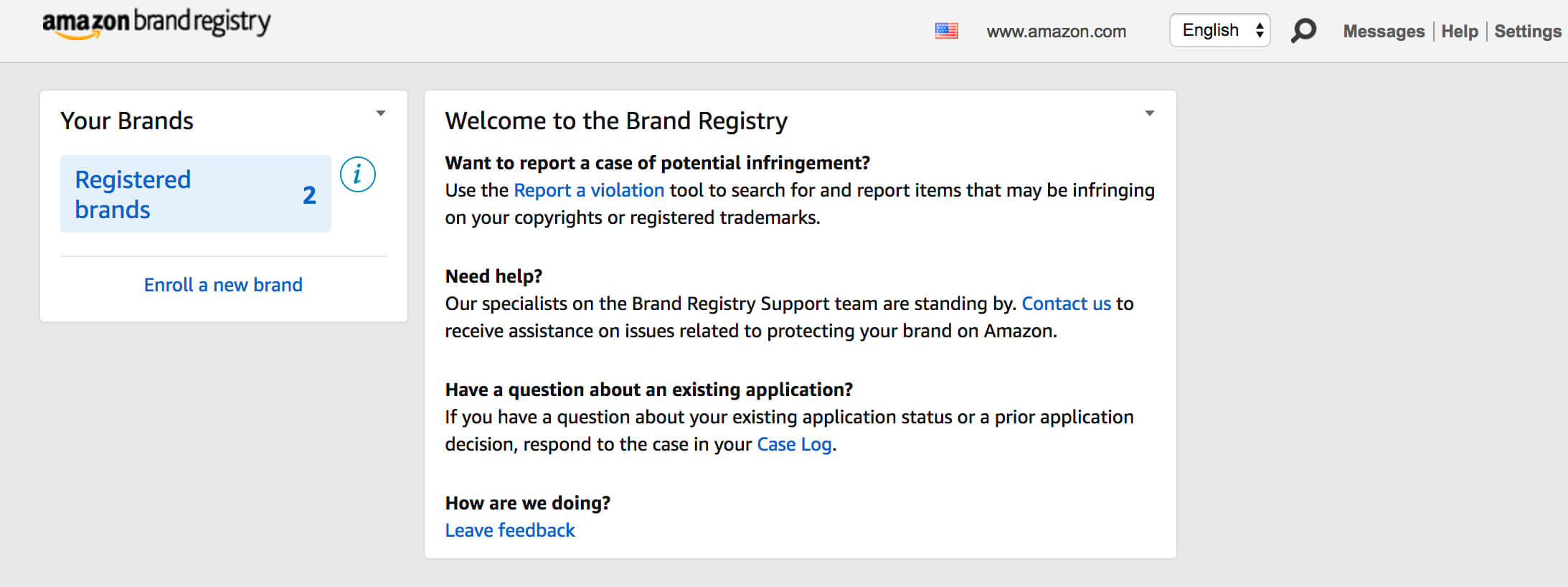
Pictured above, you can see your registered brands in the panel on the left hand side, which you could never see before in the old Brand Registry.
One really cool feature is that you can search for violations of your brand, by product name, ASIN, brand name, images or even keywords:
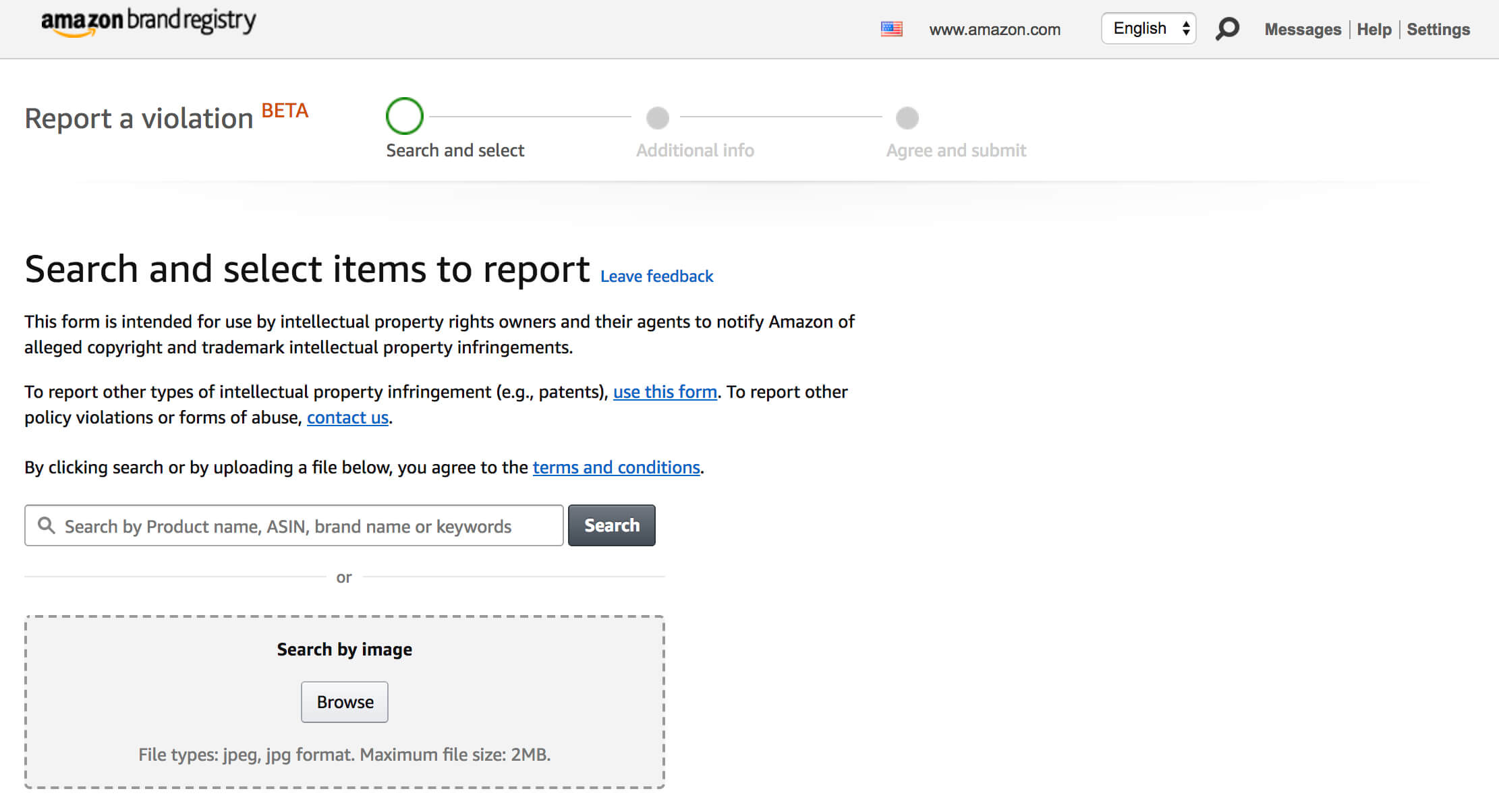
Here’s an example of a search for “Jungle Stix”:
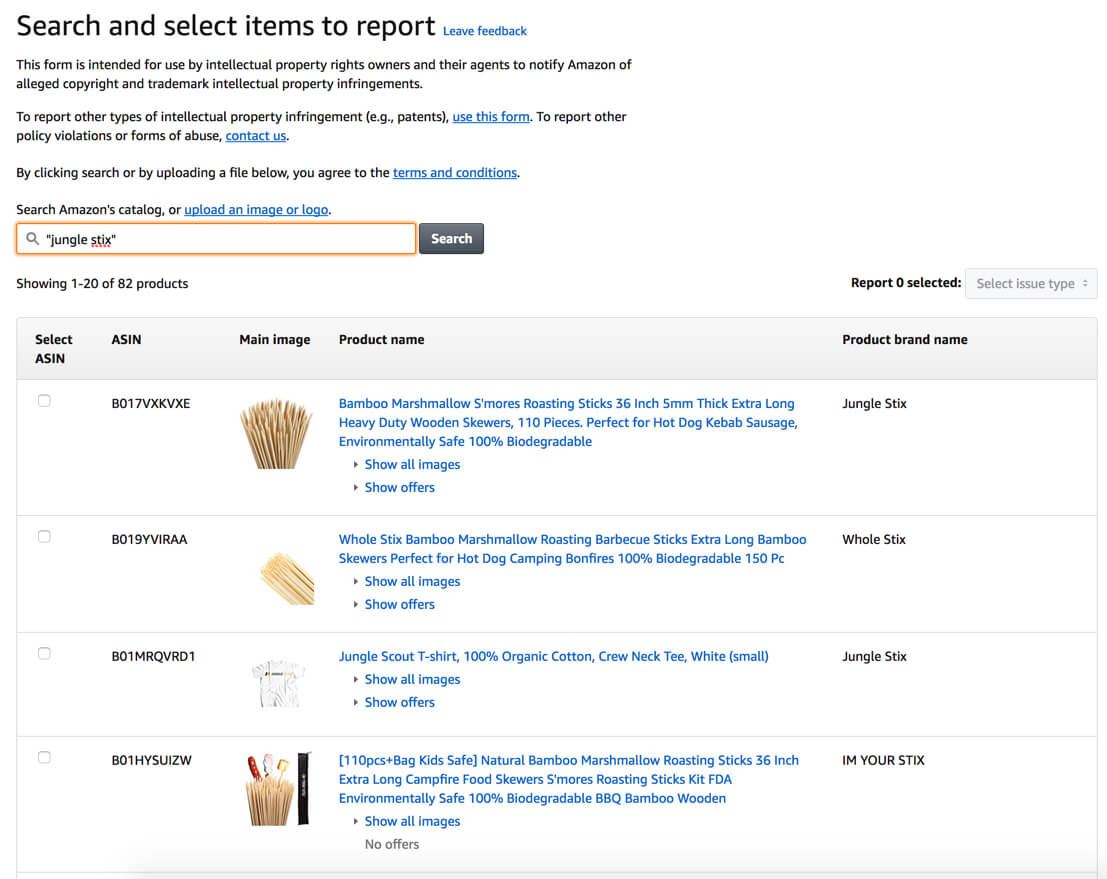
We can see here that the second and fourth listings could be illegally using a Jungle Stix trademark, so this can be easily reported to Amazon using this new feature.
Trademarking – How It Works
A trademark is a word, phrase, symbol, and/or design that identifies and distinguishes the source of the goods of one party from those of others. – USPTO
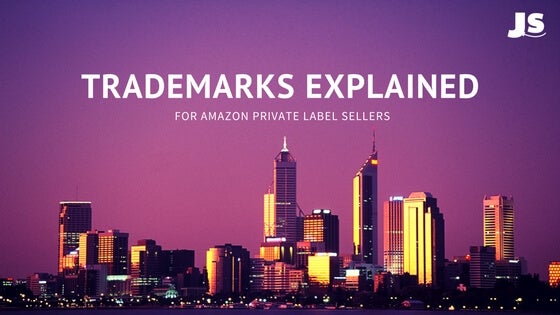
It’s a pretty simple concept and it’s actually much easier to obtain than you might imagine.
For our latest case study product, the Jungle Snugs baby hooded towels, Greg has filed for a Trademark with trademarkengine.com for $349. This includes the filing fee, the website is very easy to use and the whole process was completed in under 10 minutes. We will report back on the results, but so far this has been a good experience and it was cheaper than other alternatives.
Your application will still be filed with the U.S. Patent and Trademark Office (USPTO).
What you will need to register your Trademark:
- A legal business, or you can register as an individual with an EIN code if you are just starting out and haven’t registered an LLC yet
- A logo or mark that you want to use
- A full legal name and address of the owner (seller)
- A copy of the product as an example that shows how you are using your mark in commerce – this could be a picture of your product
- The date you first started using your logo or mark or shared it anywhere
- Which International Class you plan to use (trademarkengine.com gives you a dropdown to select your International Class)
Further Tips Before Filing For A Trademark
Think about how easy your brand will be to Trademark. In fact, if you are just launching a new branded product, you may want to think about this ahead of time to ensure any potential Trademark you might require will get through. Here’s some rough guidelines:
Avoid names that will be difficult to trademark, for example generic names (e.g. The Garlic Press Company), geographical names (e.g. West Coast Garlic Press) or anything too descriptive (e.g. The Best Garlic Press). These are common examples that often won’t get through.
Ensure you are happy with your logo before you submit your application – you could find someone to help with design on websites like Upwork or Freeeup.
Fill in your application with as much detail as possible and if there are any reservations about why your Trademark might not get registered then it’s usually best to disclaim this, or choose a safer brand name!
What If I Don’t Want To File Multiple Trademarks?
If you are wanting to avoid applying for (and paying for) several Trademarks for all of your products, there is a workaround.
Instead of using your individual product names as the brand name, you could instead use more of an open-ended brand name, which only needs to appear on your packaging somewhere to allow you to use this as a trademark.
For example, instead of applying for trademarks for Jungle Stix and Jungle Snugs, we could have instead applied for a trademark for Jungle Creations, and then packaged the products as “Jungle Stix by Jungle Creations” and so on.
If you are worried about intellectual property, or someone actually stealing your product names, then in order to get legal protection you would need to file for separate registered trademarks. But if you are just wanting to get your entire product range into the Brand Registry, then using an open-ended brand name and getting one Trademark may be the best route for you.
Tips for International Sellers
When it comes to selling internationally, the trademark process becomes a little bit conflated. First of all there is the “Madrid system” which basically means there is a treaty whereby a trademark in one territory then it can be extended to other territories.
If this sounds too good to be true, it probably is. As far as I am aware, if you wanted to pursue legal action for your trademark in a different territory to where it was registered then it would be more complex, costly and time-consuming.
There is also the World Intellectual Property Organization (WIPO), which allows you to register a trademark internationally, as well as a European Union IPO office.

If you are selling in two marketplaces, for example the US and Europe, then you may want to consider which type of trademark(s) to get.
The UK Amazon Brand Registry page, for example, states that you need:
“Please note, we currently only accept fully-registered word marks that have been issued by national government trade mark offices in France, Germany, Italy, Spain, and the United Kingdom, or by the European Union Intellectual Property Office.”
This means you would need a UK or EU trademark to access the UK Brand Registry. Conversely, On the US Brand Registry page, it now states:
Please note, we currently only accept active word marks that have been issued by government patent and trademark offices in the United States, Canada, Mexico, India, Japan, France, Germany, Italy, Spain, the United Kingdom, and the European Union. Updates to the Brand Registry eligibility criteria will be posted to this page.
This may or may not change in the future, but as it stands, if you are considering becoming an international seller, then it may be cheaper and easier to just apply for one Trademark in Europe, which would allow you to apply for Brand Registry in the US, as well as the next two biggest marketplaces, the UK and Germany.
However, be warned that doing it this way does not necessarily mean you are fully protected legally across these marketplaces (if you wanted to pursue legal action). However, for most FBA sellers, who are running small to medium sized businesses, and are just seeking to enter Brand Registry to get access to the benefits, this is probably more suitable.
Plus, having Brand Registry access does at least give you some protection in that Amazon are more likely to help you get any counterfeit products or listings taken down.
The ™ and the ® symbol
Here’s a fun fact: you can use the ™ symbol right now, even before you file for a Trademark, so long as you own the brand name and it’s not already in use. This symbol just means you have a non-registered mark.
Once you get a registered Trademark and a certificate to prove it, you can then use the ® symbol!
What About Barcodes?
As you may know, you will need some sort of GTIN (Global Trade Identification Number), such as a UPC code, in order to generate an FNSKU (an Amazon specific Fulfillment Network SKU), which you are required to print on all of your product packaging for the Amazon Fulfillment Centre.
For about a year now, Amazon has stated that your UPC codes must be GS1 Registered, which is the authoritative source for barcodes, for ecommerce. If you want to play by the rule book, then this is the way to go, but it’s the most expensive option.
You can still purchase UPC codes from Third Party sources at a fraction of the price, but you must be aware that this is technically against Amazon’s TOS. Many sellers are still doing this and not running into difficulty. But there’s nothing to say Amazon won’t start to clamp down on this in the future.
Having said that, this is still one method you could use to get your product out there and start generating sales, and then seek to go through the Brand Registry process when you are able.
GTIN Exemptions
In relation to UPC codes and GS1, there is another way around. Amazon has a GTIN exemption feature where you can apply to get your product listed without any form of GTIN Identifier.
In order to request a GTIN exemption, your product must not be on Amazon’s list of brands, and you must apply with the following information:
- A support letter from the brand owner, manufacturer or publisher to prove that a GTIN cannot be provided, OR,
- A list of sample products for review
Here’s the advice for submitting a list of sample products to review:
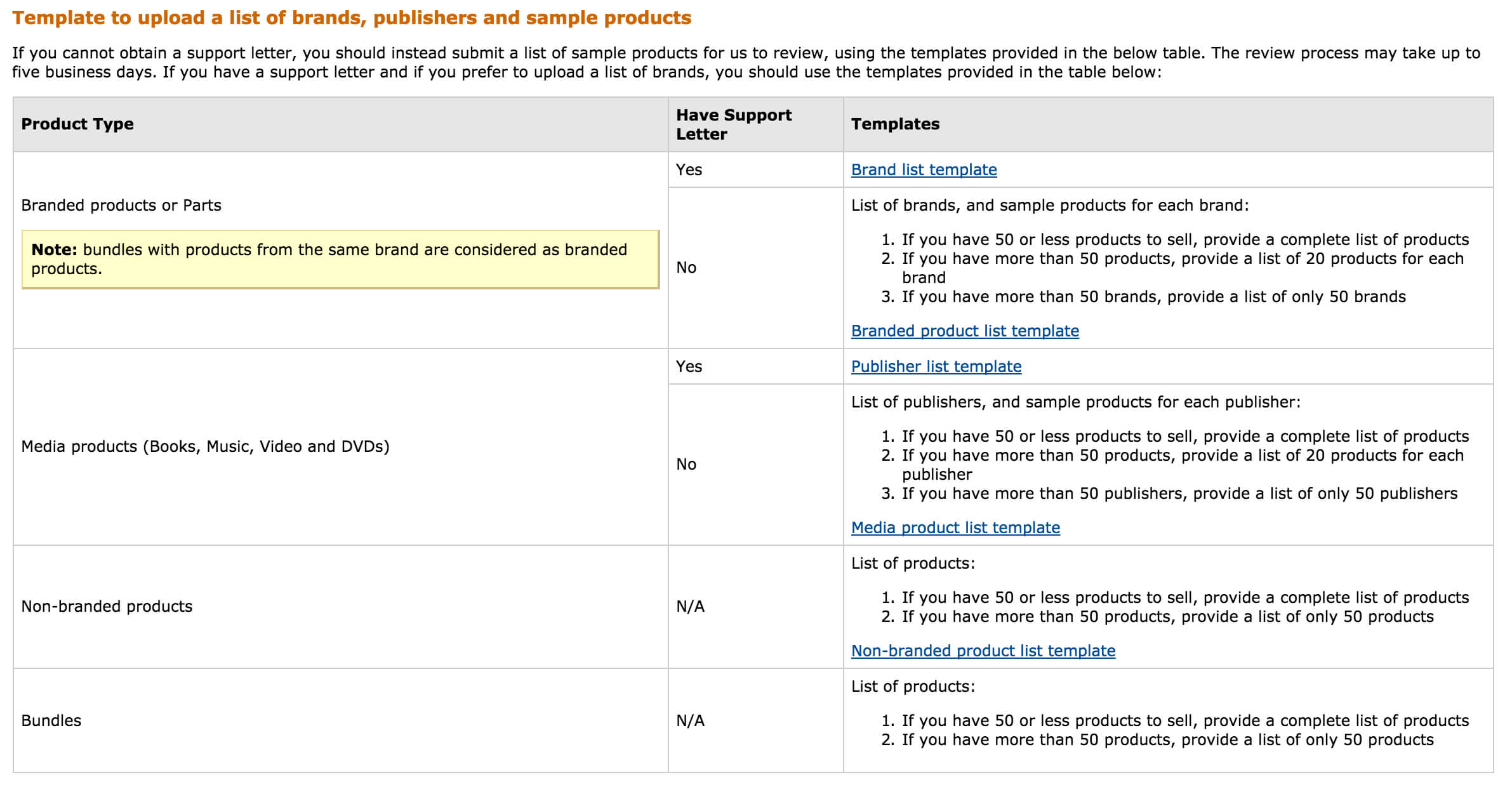
In our experience, getting a GTIN exemption isn’t common, so be prepared for this. If you have any tips of getting GTIN exemption or have any personal experience of getting approved, we’d love to hear your comments!
Private Label Product Launch Advice For Brand Registry
OK so with all of the above taken into consideration, what should your next steps be for your private label product?
Here’s a few scenarios and some ideas for how you could proceed…
1. Already a Private Label Seller?
Whether you had Brand Registry before or not, consider it. Also consider getting a registered Trademark if you haven’t already. This will allow you to move forward with the advancements Amazon are making, ensure you are protected and open up a host of listing opportunities.
2. Serious about selling on Amazon and growing a large company?
Get a Trademark from one of the lower cost sources and benefit from the advantages of doing so. It will require some upfront work and cost, but it will be worth it. Even if you are just starting out, you could start this process from day one. It all depends if you are ready for the investment!
3. Just starting out and I don’t want to register a Trademark
First try and get a GTIN exemption. If this doesn’t work out for you then you have the option to get a non-GS1 barcode from a Third Party source. This is still a method that people are using and not being penalized for. However, it is against Amazon’s TOS, so you have been warned. You could go for this method and “test” your new product on the market. Then go through the Trademark registration and Brand Registry process when your product is successful.
4. An international seller or planning to expand your Amazon business into new marketplaces
If you are a large seller, selling products in several marketplaces, then the best option would be to get an international Trademark, or apply for Trademarks in the specific territories you are selling in. But if you are currently doing really well in one marketplace, for example, the US, then start there. Finally, if you want to test the waters in a new marketplace, then you could apply the same logic in point 3 above. If it goes well, you can get a Trademark in that territory and get Brand Registry.
In a nutshell…
It very much comes down to how protected you want to be, how serious you are about building a profitable and scalable business and how risk-averse you want to be.
Experienced Amazon seller and fellow JS team member Lenny recently covered a few relevant questions about Brand Registry and GTIN exemptions in episode #22 of Ask Jungle Scout, and in episode #23 he discusses trademarks!
Conclusion
To finalize this update on Brand Registry my closing thoughts are that this is a stepping stone towards improving both the shopping experience on Amazon and improving the level of security and options sellers have.
It will prevent fraudulent and counterfeit products making their way to the Amazon marketplace, available for shoppers to buy, which is a negative experience for consumers and sellers alike.
Not only that, it looks like there are some exciting new features on the horizon for Brand Registered sellers. This will give even more ways to set yourself ahead of the competition in a growing market.
It has added a level of complexity. But these are processes that most other e-commerce businesses have been working to for years. If you’re serious about building a successful private label business that will stand the test of time, then this is part and parcel of getting yourself protected as the owner of your very own kick-ass brand!
What are your thoughts on Brand Registry? Let us know in the comments if you have started the process yet. Or have decided to go for a Trademark on your product.
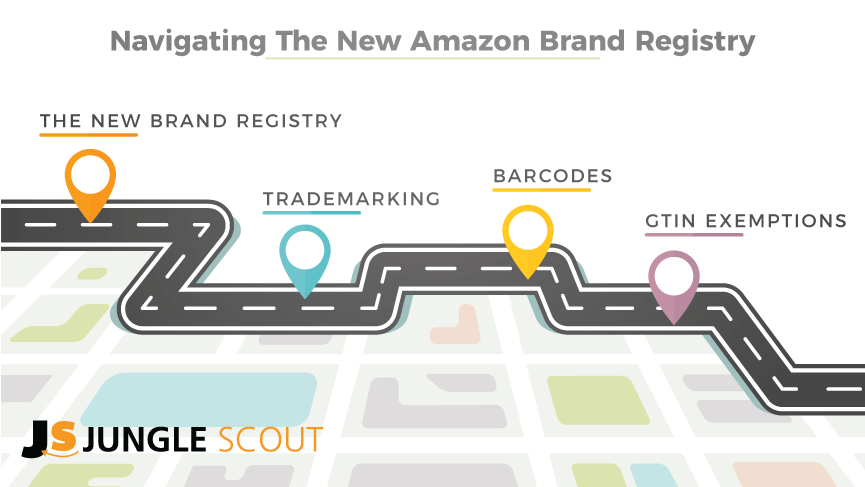
 107 Comments
107 Comments
107 comments on “Navigating The New Amazon Brand Registry”